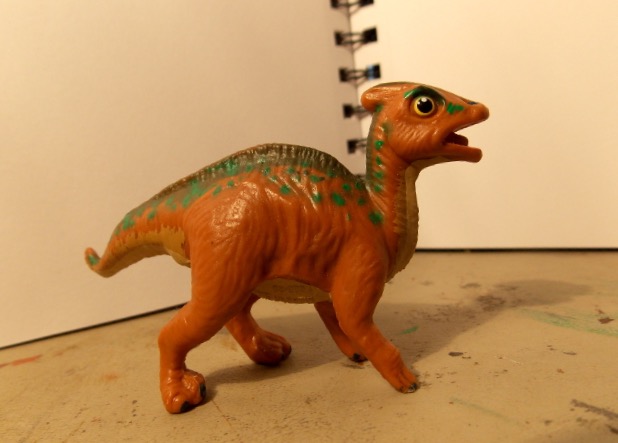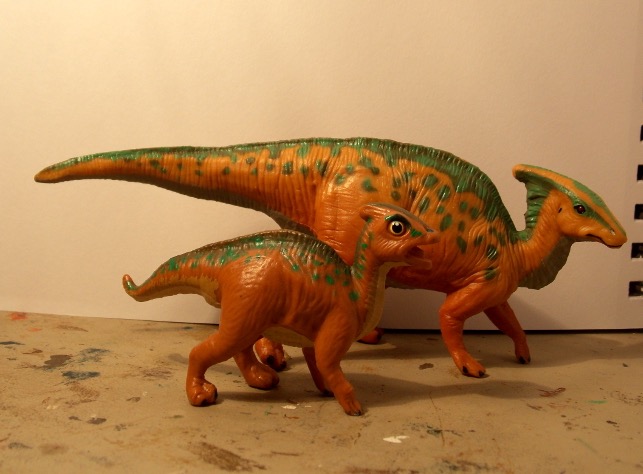Review and photos by Quentin Brendel, edited by Suspsy
With its long, tubular crest protruding from the back of its skull, Parasaurolophus is one of the most easily-recognized hadrosaurids. The model to be reviewed today does not have much of one, being a juvenile animal. Safari Ltd’s rendition, while not perfect, is still a nice toy for collectors and children alike. This figure is stamped 1997, coming out a year after the original Wild Safari adult Parasaurolophus.

The dinosaur is posed so that it looks like it is calling out, with its head up and mouth open, perhaps to the adult. The primary colour on this figure is a brownish orange, which, unlike in the adult, is solid and does not fade to a darker shade. The underside is painted beige with hard edges. There is an intermediate colour between it and the orange which has feathered edges, though it lacks the intermediate colour on the right side of the torso. The most striking part of this colour scheme are the green dorsal markings. The back is painted a dark green with lighter green patches on top of it. These markings are also on the top of the crest as well as on the dinosaur’s face. On the sides are smaller green spots which resemble the rosettes of a jaguar. On mine, these are asymmetrical with more spots on the right side. The nails are painted a navy blue and the inside of the mouth is pink. The eyes have black pupils on yellow and a white spot to simulate a reflective surface.

The neck is very thin and goose-like. Recent reconstructions depict Parasaurolophus holding its neck forward and being better-muscled, similar to a horse. The hands each have five fingers (one too many), however, only the outermost digit should have a claw. The others were bound together in a hoof-like structure with the metacarpals being longer. It is not to scale with the adult and should be smaller.

Hadrosaurs are known not only from skeletal remains, but many skin impressions as well. This makes it much easier (or harder, depending on how you look at it) to make an accurate model. The skin of the baby Parasaurolophus has large, wrinkly striations going down its neck, trunk, and tail. They are on the legs more subtly. The skin would have been scaly but the tiny scales of a hadrosaur would not be too visible at this scale anyways. Lambeosaurines also had a series of larger scales on the ventral side of the base of the tail, but even these would probably be too small to sculpt. There should be a bumpy ridge running down the length of the back as well. The most conspicuous inaccuracy of this figure is in the skull. A newly-described specimen of a baby Parasaurolophus is known to have had a crest not unlike that of a Hypacrosaurus which would have later grown into the characteristic crest of the adult parasaurolophus. Safari’s Hypacrosaurus Baby, while not perfect, would actually work better as a baby Parasaurolophus than this one.

The Wild Safari Parasaurolophus baby, despite its inaccuracies, is still a classic figure to those who (like me) grew up with the old Wild Safari line. It does go well with the adult as well as the other baby dinosaurs from the earlier years of WS. It sometimes makes its way onto eBay, but can also occasionally be found in stores with old stock and is more common (from my experience) than the adult. I happened to find three of mine at an old toy store for the great sum of seventy-five cents. Despite Parasaurolophus‘ popularity, there are not as many good figures of it as one might expect, almost none which are completely up-to-date, and very few baby dinosaurs in general.
Disclaimer: links to Ebay and Amazon on the DinoToyBlog are affiliate links, so we make a small commission if you use them. Thanks for supporting us!




This figure is okay, but yeah, the fact that it’s not to scale with the adult is a bummer :/